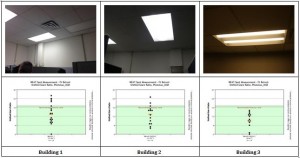Lessons Learned
We still think of buildings as investments in things: real estate, land, technology. Yet, we build to provide an environment for people to work, live, learn, play and recover from illness. Investing in people requires a dual approach of reducing risks and promoting positive experience. At the present time, building practices and standards focus on avoiding health and safety risk, such as illnesses and absenteeism associated with poor indoor air quality.
technology. Yet, we build to provide an environment for people to work, live, learn, play and recover from illness. Investing in people requires a dual approach of reducing risks and promoting positive experience. At the present time, building practices and standards focus on avoiding health and safety risk, such as illnesses and absenteeism associated with poor indoor air quality.
The concept of POE originated as one-off case study evaluation during its introduction in the 1960’s, later, evolving into a cross-sectional evaluation in the 1970’s.
User satisfaction with the building can give detailed information about the characteristics of the building, which architects, engineers and facilities management could miss. The slow speed at which this information reaches the right people at present is shocking. To understand how best to capture this information around the country and apply it is the role that POE plays.
POE commences with one fundamental question, how does one introduce the much-needed development and upgrade of buildings successfully?
CBEI has also found that IEQ is undervalued by the market when energy decisions are made. This is because human productivity valuation with respect to human comfort is not currently a financial factor in decision-making.
References
- ASHRAE. (2010). ANSI/ASHRAE Standard 55, Thermal Environmental Conditions for Human Occupancy
- ASHRAE/CIBSE/USGBC (2010). Performance Measurement Protocols for Commercial Buildings, American Society of Heating, Refrigerating and Air Conditioning Engineers
- Aziz, A., Park, J., Loftness, V., & Cochran, E. (2012). Field measurement Protocols for Evaluating Indoor Environmental Quality and User Satisfaction in Relation to Energy Efficiency U.S. DOE. The Energy Efficient Buildings Hub, Department of Energy
- Loftness, V., Aziz, A., Choi, J., Kampschroer, K., Powell, K., Atkinson, M., & Heerwagen, J. (2009). The value of post-occupancy evaluation for building occupants and facility managers. Intelligent Buildings International, 1(4), 249-268. doi: 10.3763/inbi.2009.SI04
- Loftness, V., Aziz, A., Cochran, E., Park, J., Rojas, R. M., Song, Y., & Lei, Y. (2014). Three Building Post Occupancy Evaluation & Measurement (POE+M), Fort Belvoir, PA. Phhiladelphia, PA: CBEI Report
- Park, J. Aziz, A, Loftness, V. (2013). Post-occupancy evaluation for energy conservation, superior IEQ & increased occupant satisfaction. IFMA’s World Workplace 2013.
Date: April 01, 2016
A holistic post-occupancy evaluation (POE) includes collection of field data on indoor environmental qality (IEQ), user satisfaction assessment, and the recording of the technical attributes of the building system. The traditional POE methodology is tedious and cumbersome. Simplifying IEQ measurement tools helps POE assessments become a key step in the commissioning of existing buildings. POE coupled with measurement (POE+M) can deliver a sensible return on investment when done properly.